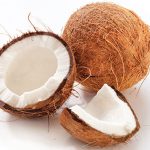 Although often confused with coca (the shrub whose leaves yield cocaine) and with cocoa (the bean that yields chocolate), the word coco as in coconut is related to neither. Both coca and cocoa developed from words native to the Americas, the former word from South America, the latter from North America; in contrast, coco is European in origin, even though coconuts are a tropical fruit. The nut acquired its name when, in the late fifteenth century, Portuguese explorers fancied that the three indentations on the base of the large, hairy nut looked like a grinning face; accordingly, they named it coconut, the word coco meaning goblin or, more literally, grin-face. In the early seventeenth century, more than a hundred years after the Portuguese sailors gave the nut its ghoulish name, the word coconut appeared in English. Surprisingly, copra, the name given to coconut flesh after its oil has been extracted, appeared in English in the late sixteenth century, about thirty years before coconut itself. Copra derives from the Hindi word for coconut, khopra.
Although often confused with coca (the shrub whose leaves yield cocaine) and with cocoa (the bean that yields chocolate), the word coco as in coconut is related to neither. Both coca and cocoa developed from words native to the Americas, the former word from South America, the latter from North America; in contrast, coco is European in origin, even though coconuts are a tropical fruit. The nut acquired its name when, in the late fifteenth century, Portuguese explorers fancied that the three indentations on the base of the large, hairy nut looked like a grinning face; accordingly, they named it coconut, the word coco meaning goblin or, more literally, grin-face. In the early seventeenth century, more than a hundred years after the Portuguese sailors gave the nut its ghoulish name, the word coconut appeared in English. Surprisingly, copra, the name given to coconut flesh after its oil has been extracted, appeared in English in the late sixteenth century, about thirty years before coconut itself. Copra derives from the Hindi word for coconut, khopra.
Matured coconut fruits are comprised of a robust shell and white pulp from the coconut palm tree. Conversely, juvenile coconut fruits are softer during the initial phases of maturation and lack a solid exterior. The sapid liquid enclosed within immature coconuts can serve as a delightful alternative to dairy products.
The drupe of the Cocos nucifera, thriving in a plethora of tropical habitats, albeit commonly associated with the Pacific archipelagos. A mature specimen can generate over a hundred fruits per annum. A verdant fruit encompasses a condensed gelatinous substance and a limpid liquid called coconut water, which are both mouthwatering. Occasionally, the fluid is subjected to fermentation to concoct palm wine.
